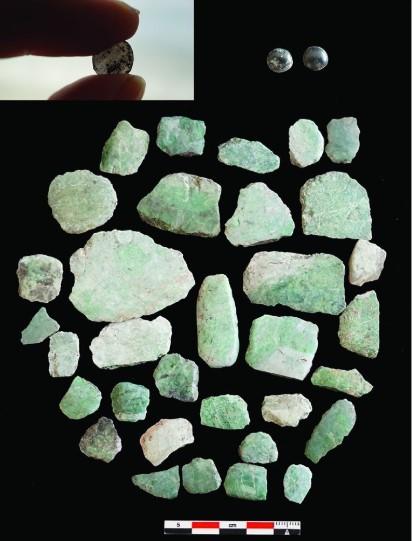As the Maya civilization began to crumble during the 9th century CE, a corner of the realm became embroiled in a dramatic revolution. Astonishing evidence for this political upheaval has now been discovered in an ancient pyramid in Guatemala, where researchers have found the burnt remains of Maya royalty, hinting at a fiery public display of regime change.
While excavating the structure at the pre-Columbian city of Ucanal – the capital of the ancient K’anwitznal kingdom – archaeologists came across the charred remains of at least two people accompanied by the kinds of lavish items typically found in royal Maya tombs. Among the objects found alongside the scorched individuals was a greenstone mask – a telltale sign that the deceased were once rulers of K’anwitznal.
Radiocarbon dating revealed that the burning occurred between 773 and 881 CE and that the victims had been dead for some time before their incineration. This, in turn, suggests that their original tombs had been reopened with the specific intention of burning their dead royal asses.

Fragments of a jade mask with an obsidian eye, found alongside the burnt royal remains.
Image credit: C. Halperin
Interpreting the discovery in a new study, the researchers reveal that this desecration coincided with the emergence of a new political regime in K’anwitznal, led by a ruler called Papmalil who oversaw major structural changes within Maya society. Describing his emergence as a “revolutionary pivot point”, the study authors describe how Papmalil did away with the social hierarchy, ushering in a new era of egalitarianism in which “distinctions between elite and non-elite households [were] greatly diminished.”
Comparing this shift to the French Revolution, the researchers say that the ceremonial burning of former rulers served a similar purpose to the storming of the Bastille, in that it provided a symbolic moment of political transformation.
“The fire-burning event of the burial deposit was likely a dramatic public affair,” explained study author Dr Christina T. Halperin in a statement. “Because the fire-burning event itself had the potential to be highly ceremonial, public and charged with emotion, it could dramatically mark the dismantling of an ancient regime.”
Following Papmalil’s rise, many of the buildings at Ucanal were demolished and their facing stones were used as filler in new monumental constructions in order to “bury the symbols of an earlier regime,” the researchers write. Likewise, the burnt royal remains were “dumped at the edge of a crude wall used as a construction pen,” with no effort made to protect the bones or ornaments from the “stone blocks deposited on top of them as construction fill.”
“The fire-burning event itself and the reign of Papmalil helped usher in new forms of monumental imagery that emphasised horizontal political ties and fundamental changes in the social structure of society,” said Halperin. “In this sense, it was not just an end of an era, but a pivot point around which the K’anwitznal polity, and the Maya of the southern Lowlands in general, transformed themselves anew.”
The study is published in the journal Antiquity.
Source Link: Burnt Remains Of Maya Rulers Hint At Fiery Political Revolution